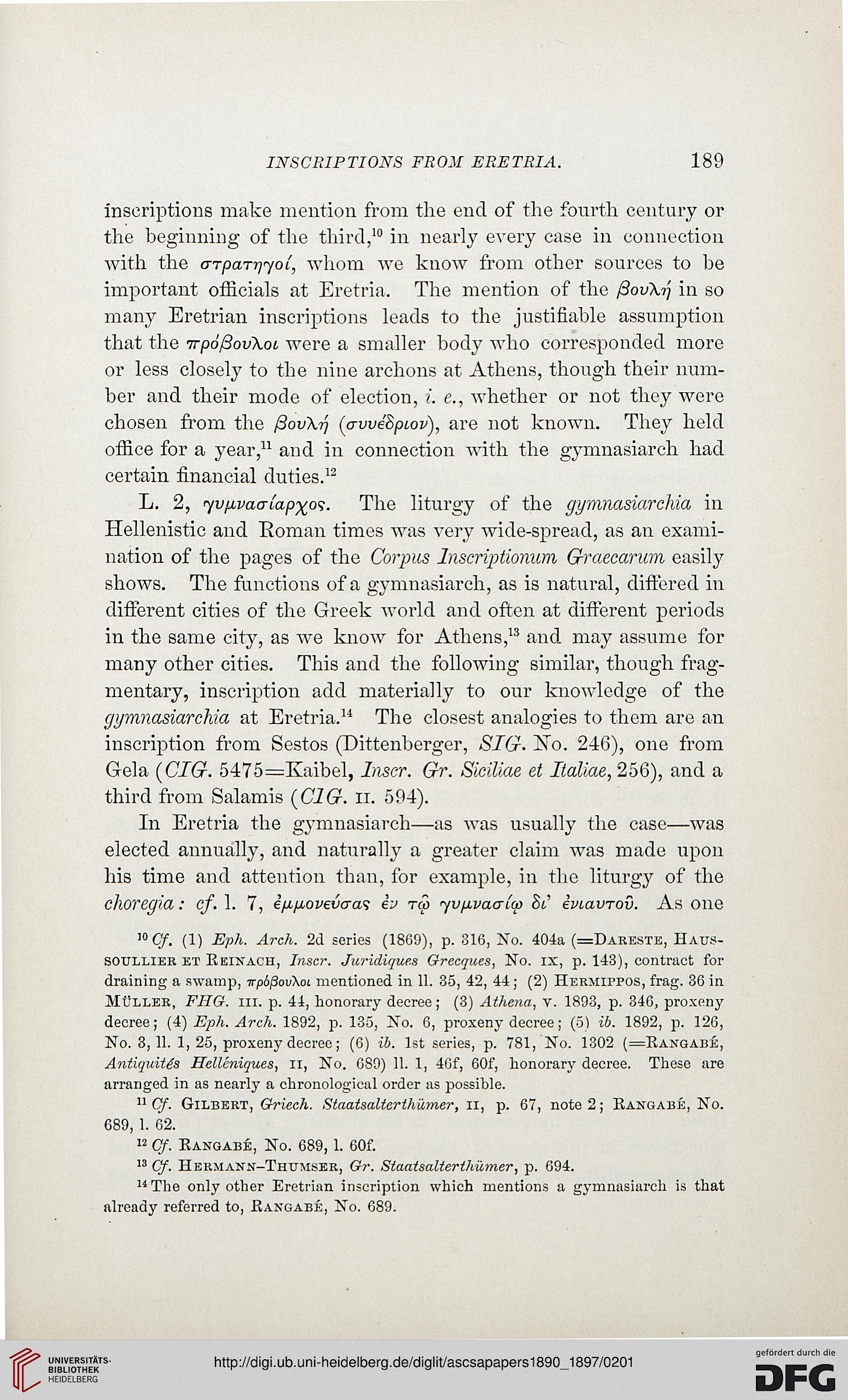INSCRIPTIONS FEOil EEETEIA.
189
inscriptions make mention from the end of the fourth century or
the beginning of the third,10 in nearly every case in connection
with the arpaTi^joi, whom we know from other sources to be
important officials at Eretria. The mention of the fiovXij in so
many Eretrian inscriptions leads to the justifiable assumption
that the Trp6/3ov\oi were a smaller body who corresponded more
or less closely to the nine archons at Athens, though their num-
ber and their mode of election, i. e., whether or not they were
chosen from the (3ov\rj (a-vve'Spiov), are not known. They held
office for a year,11 and in connection with the gymnasiarch had
certain financial duties.13
L. 2, yvfivacriapxos. The liturgy of the gymnasiarchia in
Hellenistic and Roman times was very wide-spread, as an exami-
nation of the pages of the Corpus Inscriptionum Graecarum easily
shows. The functions of a gymnasiarch, as is natural, differed in
different cities of the Greek world and often at different periods
in the same city, as we know for Athens,13 and may assume for
many other cities. This and the following similar, though frag-
mentary, inscription add materially to our knowledge of the
gymnasiarchia at Eretria.14 The closest analogies to them are an
inscription from Sestos (Dittenberger, SIG. No. 246), one from
Gela (CIG. 5475=Kaibel, Inscr. Gr. Siciliae et Itallae, 256), and a
third from Salamis (C1G. II. 594).
In Eretria the gymnasiarch—as was usually the case—was
elected annually, and naturally a greater claim was made upon
his time and attention than, for example, in the liturgy of the
choregia : cf. 1. 7, if^p.ovevaa'i ev tc3 yvfivaaia) tV eviavTOv. As one
10 Cf. (1) Eph. Arch. 2d series (1869), p. 316, No. 404a (=Dareste, Hatjs-
soullier et Reinach, Inscr. Juridiques Grecques, No. ix, p. 143), contract for
draining a swamp, wpbfSovKoi mentioned in 11. 35, 42, 44; (2) Hermippos, frag. 30 in
Muller, FUG. in. p. 44, honorary decree; (3) Athena, v. 1893, p. 340, proxeny
decree; (4) Eph. Arch. 1892, p. 135, No. 6, proxeny decree; (5) ib. 1892, p. 120,
No. 3, 11. 1, 25, proxeny decree; (0) ib. 1st series, p. 781, No. 1302 (=Ranqabe,
AntiquiUs Hellcniques, n, No. G89) 11. 1, 40f, GOf, honorary decree. These are
arranged in as nearlj' a chronological order as possible.
11 Cf. Gilbert, Griech. StaatsaUerthumer, ii, p. 07, note 2; Rangare, No.
689, 1. 62.
12 Cf. Rangabe, No. 689,1. 60f.
13 Cf. Hermann-Thtjmser, Gr. StaatsaUerthumer, p. 094.
"The only other Eretrian inscription which mentions a gymnasiarch is that
already referred to, Rangabe, No. 689.
189
inscriptions make mention from the end of the fourth century or
the beginning of the third,10 in nearly every case in connection
with the arpaTi^joi, whom we know from other sources to be
important officials at Eretria. The mention of the fiovXij in so
many Eretrian inscriptions leads to the justifiable assumption
that the Trp6/3ov\oi were a smaller body who corresponded more
or less closely to the nine archons at Athens, though their num-
ber and their mode of election, i. e., whether or not they were
chosen from the (3ov\rj (a-vve'Spiov), are not known. They held
office for a year,11 and in connection with the gymnasiarch had
certain financial duties.13
L. 2, yvfivacriapxos. The liturgy of the gymnasiarchia in
Hellenistic and Roman times was very wide-spread, as an exami-
nation of the pages of the Corpus Inscriptionum Graecarum easily
shows. The functions of a gymnasiarch, as is natural, differed in
different cities of the Greek world and often at different periods
in the same city, as we know for Athens,13 and may assume for
many other cities. This and the following similar, though frag-
mentary, inscription add materially to our knowledge of the
gymnasiarchia at Eretria.14 The closest analogies to them are an
inscription from Sestos (Dittenberger, SIG. No. 246), one from
Gela (CIG. 5475=Kaibel, Inscr. Gr. Siciliae et Itallae, 256), and a
third from Salamis (C1G. II. 594).
In Eretria the gymnasiarch—as was usually the case—was
elected annually, and naturally a greater claim was made upon
his time and attention than, for example, in the liturgy of the
choregia : cf. 1. 7, if^p.ovevaa'i ev tc3 yvfivaaia) tV eviavTOv. As one
10 Cf. (1) Eph. Arch. 2d series (1869), p. 316, No. 404a (=Dareste, Hatjs-
soullier et Reinach, Inscr. Juridiques Grecques, No. ix, p. 143), contract for
draining a swamp, wpbfSovKoi mentioned in 11. 35, 42, 44; (2) Hermippos, frag. 30 in
Muller, FUG. in. p. 44, honorary decree; (3) Athena, v. 1893, p. 340, proxeny
decree; (4) Eph. Arch. 1892, p. 135, No. 6, proxeny decree; (5) ib. 1892, p. 120,
No. 3, 11. 1, 25, proxeny decree; (0) ib. 1st series, p. 781, No. 1302 (=Ranqabe,
AntiquiUs Hellcniques, n, No. G89) 11. 1, 40f, GOf, honorary decree. These are
arranged in as nearlj' a chronological order as possible.
11 Cf. Gilbert, Griech. StaatsaUerthumer, ii, p. 07, note 2; Rangare, No.
689, 1. 62.
12 Cf. Rangabe, No. 689,1. 60f.
13 Cf. Hermann-Thtjmser, Gr. StaatsaUerthumer, p. 094.
"The only other Eretrian inscription which mentions a gymnasiarch is that
already referred to, Rangabe, No. 689.




